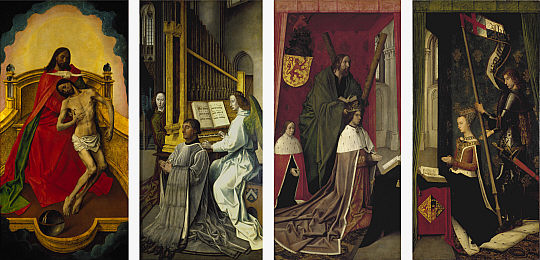Trinity Altarpiece

The Trinity Altarpiece, also known as the Trinity Altar Panels, is a set of four paintings in oil on wood thought to have been commissioned for the Trinity College Kirk in Edinburgh, Scotland, in the late fifteenth century.
The work is attributed to the Flemish artist Hugo van der Goes and probably represents the inner and outer panels of the wings of a triptych. The presumed central panel is lost.[1] The painting in the church was described as a "burd" on 17 May 1516 when John Stewart, Duke of Albany made an offering at the high altar on Trinity Sunday.[2]
The work represents a rare example of religious art in Scotland to have survived the iconoclasm of the Scottish Reformation in 1560. The painting was taken to England at the Union of the Crowns and was part of the collection of Anne of Denmark, wife of James VI and I, at Oatlands.[3] In 1618 she gave it to her son Prince Charles, who presented the painting to the Duke of Buckingham.[4]
The panels are part of the British Royal Collection and are displayed at the Scottish National Gallery.[5]
Description[edit]
The four panels depict the following subjects:
- The Holy Trinity.
- A praying cleric, thought to be the contemporary Provost of Trinity College Kirk, Edward Bonkil,[5] accompanied by two angels playing an organ.
- King James III of Scotland at prayer attended by Saint Andrew and a boy who may be the future King James IV.[1] The royal arms of Scotland hang from a wall.
- Queen Margaret of Scotland at prayer attended by Saint George. Her royal arms decorate her lectern.

Edward Bonkil[edit]
Edward Bonkil was a member of a wealthy Edinburgh merchant family with commercial connections in Bruges.[6] His father, Robert Bonkil, owned a house in Bruges. Edward's older brother, Alexander Bonkil, was a member of the Bruges Confraternity of the Holy Snow.[7]
He may have commissioned the altarpiece to strengthen ties of the Trinity Collegiate Church with Margaret of Denmark, and the imagery used may express her interests and personal iconography.[8]
See also[edit]
- List of works by Hugo van der Goes
- Hours of James IV of Scotland
- Portinari Altarpiece
- Madonna in the Church
References[edit]
- ^ a b The Royal Collection
- ^ Accounts of the Lord High Treasurer of Scotland, vol. 5 (Edinburgh, 1903), 79 "for offerand to the He Altar and burd".
- ^ Jill Harrison, 'Fresh Perspectives on Hugo van Goes' Portrait of Margaret of Denmark and the Trinity Altarpiece', The Court Historian, 24:2 (2019), p. 123 doi:10.1080/14629712.2019.1626108
- ^ Wendy Hitchmough, 'Setting the Stuart court: placing portraits in the performance of Anglo-Spanish negotiations', Journal of the History of Collections, 32:2 (July 2020), pp. 245-264.
- ^ a b National Galleries of Scotland
- ^ Lorne Campbell, 'Edward Bonkil: A Scottish Patron of Hugo van der Goes', The Burlington Magazine 126 (1984), pp. 265-74.
- ^ Lorne Campbell, 'Edward Bonkil and Hugo van der Goes', The Burlington Magazine, 143:1176 (March 2001), pp. 157-15.
- ^ Jill Harrison, 'Fresh Perspectives on Hugo van Goes' Portrait of Margaret of Denmark and the Trinity Altarpiece', The Court Historian, 24:2 (2019), pp. 120-138.
